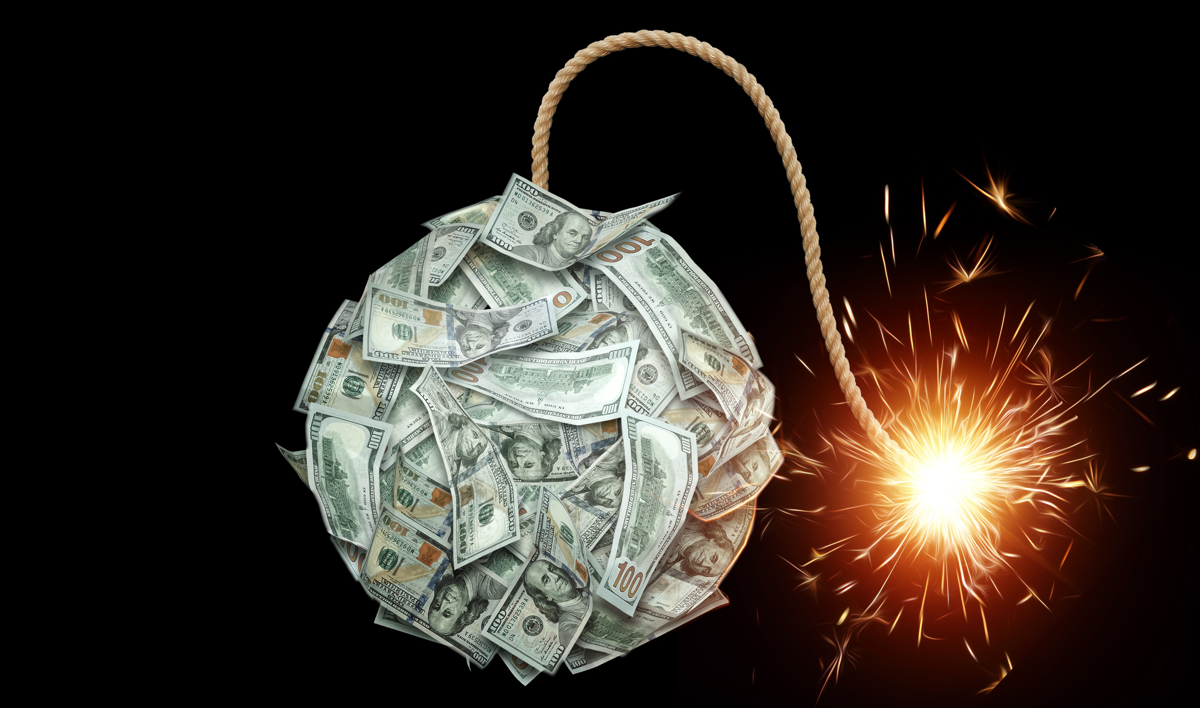
The Dollar See-Saws between Two Views on Fiscal Explosion
Fiscal explosion is not in the economic dictionary. But in the foreign exchange markets and bond markets this intuitive concept has sometimes powered a narrative which drives long-term US interest rates and the dollar upward in tandem. The puzzle to explain at such times, whether the early 1980s, or autumn 2023, is why the dollar shrugs off the inflation danger of so much red ink in the government accounts.
Let’s start with the proposal for a new entry to the lexicon. A fiscal explosion is a suddenly perceived alarming deterioration in the public finances, now and in the future. Perceptions are the crucial element here. The underlying reality of government finances might have been deteriorating for some considerable time before this impacts investor analysis and decision making.
Fiscal explosion this year has taken the form of serious upward revisions of estimates and projections for the US budget deficit as driven by “Bidenomics.” According to standardized International Monetary Fund (IMF) metrics the US general government deficit has climbed in 2023 to above 8 percent of gross domestic product (GDP) compared to under 4 percent last year; debt of the Federal debt already surpasses $30 trillion, all with the US economy apparently “at full stretch.”
The dominant view in the currency marketplace as evidenced by the dollar’s stellar performance is that like forty years ago the Federal Reserve will successfully fortify and defend the monetary barriers against the danger of inflation from ailing public finances. The Fed’s propaganda “higher for longer” has excited audiences who seem convinced that US interest rates in real and nominal terms will stay at a super-attractive by global comparison.
This view does not have recent history or facts about the actual US monetary regime on its side. The experience of the Great Pandemic Inflation demonstrates that the status quo monetary regime (the so-called 2 percent inflation standard) failed to prevent fiscal explosion during 2020–21 (when the general government deficit expanded to an average 13 percent of GDP from around 6 percent in 2019) setting off a wave of monetary inflation.
Advocates of the so-called fiscal theory of inflation argue that monetary failure then was no accident but a virtual plot. The pandemic featured a massive gap in the US budget, and the Federal Reserve and the US government conspired to create monetary inflation with the intention of reducing debt service in real terms to a sustainable level.
Granted, that doomsday hypothesis about inflation as a contrived outcome of unsustainable government finances is somewhat speculative rather than tautological. Default on government debt by inflation can have heavy political cost. After all some pundits maintain low approval ratings of President Biden stems to a considerable degree from voters’ dissatisfaction with prices still 20 percent above the eve of pandemic level.
That lesson could conceivably foster political forces which would reform the monetary system such as to install a solid anchor which would prevent fiscal or supply shocks driving up inflation. Such a faint prospect, however, does not justify a sustained rerun of the early 1980s dollar experience.
In those halcyon days the Reagan fiscal explosion was accompanied by a powerful rise of the US dollar. That may have seemed to some at first sight like a textbook demonstration of the popular Mundell-Fleming model of how fiscal policy works in an open economy. According to this, a big fiscal deficit accompanied by a strict monetary policy puts upward pressure on interest rates which pull in capital and so cause the domestic currency to appreciate.
Yet there was much else going on. High rates in the United States during the early 1980s reflected dynamism of the US economy under the influence of free-market economic policy and related deregulation. Crucially, the implementation of the Volcker monetarist experiment triggered a big increase in demand for the dollar compared to the previous decade when soft money policies had been in the ascendant.
All of that, however, is far away from the actual situation of the Great Pandemic Inflation and its aftermath. Under the actual monetary regime, any resistance to fiscal inflation depends in practice on the Fed choosing at its discretion a path for its policy interest rate which turns out to be restrictive. For now, the sentiment amongst powerful actors in the foreign exchange market seems to be that the Fed can be trusted to accomplish this feat.
The sceptics, who include advocates of the fiscal theory of inflation, can caution us that this newly trusted Fed and those it answers to especially in Congress will conspire yet again to bring about a big fall in the real value of debt. The readiness of the Fed and its overseers to ignore inflation dangers outside their highlighted optimistic central scenario, reflect the potential gains of this whether for Big Government or highly leveraged private sector borrowers.
The theory of fiscal inflation does not depend on an explicit plot between the central bank and Congress to levy inflation tax. Rather, there could be a conspiracy of silence about the danger of high inflation. Or there may be no new plot at all. High inflation could emerge simply due to a lack of any solid anchor in the status quo monetary regime. The longevity of that regime, though, would reflect a continuation of an old plot to remain silent about the regime’s flaws.
Under such flawed systems, the increase in spending which accompanies the explosion (unless there is a powerful Ricardo effect) tends to drive prices to a higher level and this will meet no counterforce from a monetary anchor. Strikingly, in the currency marketplace today, concerns about fiscal explosion proving to be inflationary are most evident in the case of Japan.
Specifically, Japan’s gross public sector debt now surpasses 255 percent of GDP whilst big new budget expenditures (including military commitments to the US and preelection handouts by the unpopular Kishida government facing competition from a populist party to its right) mean that the current deficit is still above 6 percent of GDP even though debt servicing costs are held down by negative interest rate policy and yield curve control.
The yen has plunged to 150 against the dollar as conspiracy between the government and central bank to reduce debts in real terms is so live a fear and prospects of monetary reform to establish a solid anchor are totally remote. In the US, by contrast to Japan, the case for monetary reform may yet reenter the political stage in coming years not least in view of inflation’s evident unpopularity.
Fiscal explosion, given a solid anchor, would not send goods and services prices up to a sustained higher level. In view of higher incomes and prices individuals would find themselves short of base money. If indeed monetary base is on a preprogrammed low rate of expansion, fiscal explosion could eventually drive prices to a level lower than at the start. That outcome would reflect the rise in demand for base money induced by higher personal incomes in real terms as induced by tax cuts and subsidy receipts.
Back to the reality of late Autumn 2023, the “rates higher for longer” show features king dollar on top of the world. That show is not likely to have a long run unless the looming elections provide justification for expecting monetary reform in the US. A still-flickering candle of hope about sound money renaissance and Fed propaganda about skill in policy rate piloting is not sufficient to dissipate inflation menace.



